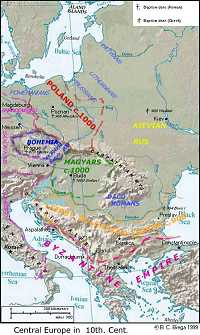 |
Two Thousand Years of the Modern Era in Eastern Europe Part 1: The End of the First Millenium. |
Bill Biega's History Essays |
|
Biega Home Page
Consulting Using special characters. East Europe Cities, Countries, Info. History Genealogy, History Essays Maps Cities, Countries, Historical Photo Gallery Places I visited Rydzyna Sailing all over the world Syrena Press 13 Is My Lucky Number Learning LINUX 
Contact us by Email |
Click on any illustration with colored border to see it full size. Then click on "Back" button to return to this page.
The original Illyrian peoples of the Danube basin retreated into the mountains bordering the Adriatic Sea and became the modern day Albanians. In the 9th. Cent., a nomadic warrior people from east of the Ural mountains, the Magyars, moved across the Carpathian passes, and finally settled down in the rich plains of the Danube valley, displacing the Slavs who had arrived earlier and founding the Hungarian nation. In the area north of the Danube, within the curve of the southern Carpathian Mountains, lived the ancient Dacians. The Romans had previously invaded and colonized the area, but cut off from Rome by the advance of Slavs to the west, the remaining Romans intermarried with the local population. As a result, modern
Romania has a language strikingly similar to Italian.
The other peoples of north-eastern Europe were the Baltic peoples of the coastal plains, whose descendants are today's Lithuanians and the Latvians. Another tribe from east of the Urals settled in Finland and Estonia, who today speak a language vaguely related to Hungarian. At the end of the first Millennium of the New Era, all of Central and Eastern Europe was beginning to stabilize. For the next thousand years continued pressure existed. From the west the Germans pushed relentlessly eastward. From the east, for several centuries transient onslaughts of Mongols (Genghis Khan) and Tartars caused devastation, later the growing Russian empire pushed westward. From the south the Turks pushed northward. But the tribes that had settled the region coalesced first into principalities, then into kingdoms as they converted to Christianity. Latin speaking monks baptized the Bohemian prince
Vaclav in 921, the Polish prince
Mieszko in 966 and the Magyar prince
Stefan in 1,000. All three received crowns from the Pope and established the Premyslid, Piast and Arpad royal dynasties. The Croats, Slovaks and Slovenians also became Christianized during the same period. The new kings quickly consolidated their realms into strong states, often competing with each other.
At the end of the Millennium, the southern part of the Balkan peninsula, including Greece and much of Asia Minor (present day Turkey), was still ruled by Byzantium, in spite of the influx of new peoples. The Roman Empire had split into two in the early part of the first Millennium. Emperor Constantine had proclaimed the Christian faith to be the official religion of the Roman Empire in 313. Several years later he established Constantinople as the capital of the Eastern Empire. While the Western Empire disintegrated under the onslaught of the Vandals, Ostrogoths and Lombards, the eastern empire, Byzantium, continued to flourish until the end of the Millennium. However, the predominant language was Greek instead of Latin. The liturgy of the Christian church in the east was also conducted in Greek. Frictions between the bishops of Constantinople and the Pope in Rome resulted in a separation of the Church into Western and Eastern Rites. Two monks from Thessalonica, Cyril and Methodius created a Slavonic alphabet, based on the Greek. They then translated the Holy Scriptures into the Slavonic language. This eased the process of converting the pagan Slavs. Tsar Boris I of Bulgaria was baptized in 864, zupan Mutimir of Serbia in 879, Vladimir of Kiev in 989. The eastern Slavic nations created national Orthodox denominations, of which the most powerful and enduring were the Bulgarian, Russian and Serb churches. The resulting division of Slavic peoples into Roman Catholics and Orthodox had far reaching effects in the 19th and 20th centuries. In the short run these national churches gave their monarchs tremendous influence. The Bulgarian monarchy battled Byzantium for supremacy in the southern Balkan peninsula for 200 years. Finally Tsar Samuil of Macedonia was defeated in 1014, and 15,000 of his soldiers were blinded by the victorious Byzantines. Subsequently, Tsar Stephen IV Dusan of Serbia took advantage of the weakening of Byzantium under the onslaught of the Ottoman Turks. He occupied all of western Byzantium in 1350, but less than 50 years later Serbia, too, was defeated by the Turks. This brief summary does little justice to the complex history of hundreds of years at the end of the First Millennium. Please follow up on the many links to learn more. Return to Top of page. Return to History Table of Contents for other History Essays. |
|
Return to Home Page.
Last update May 2007 |

